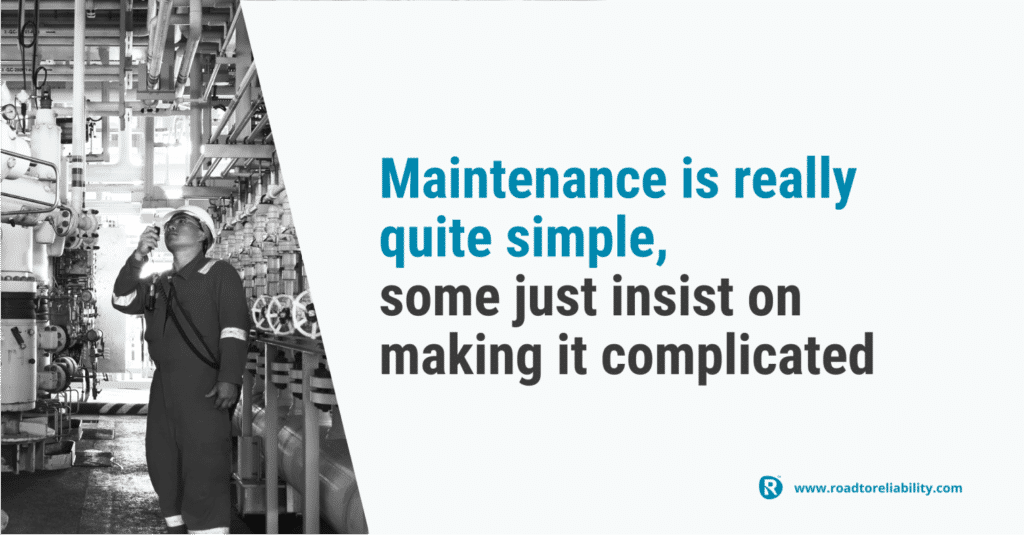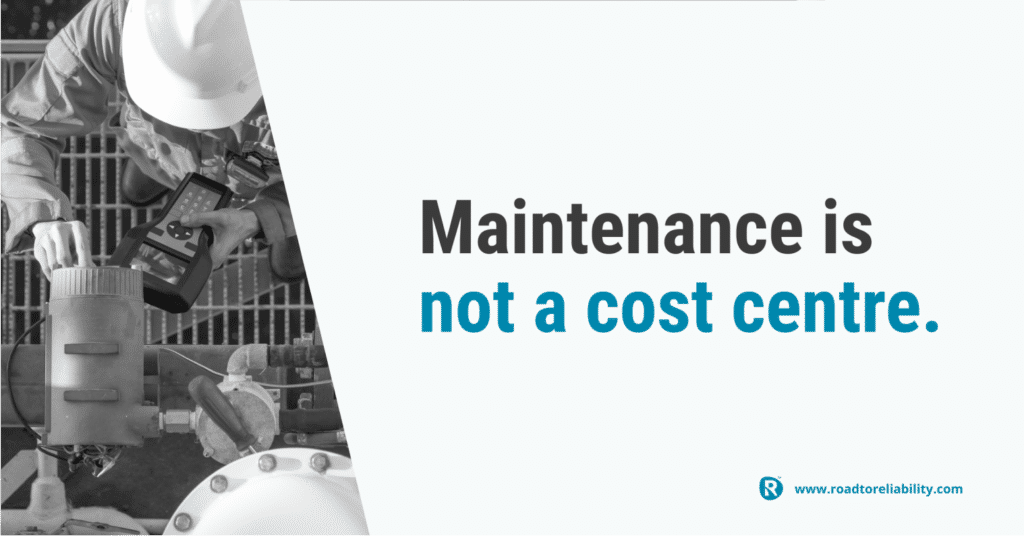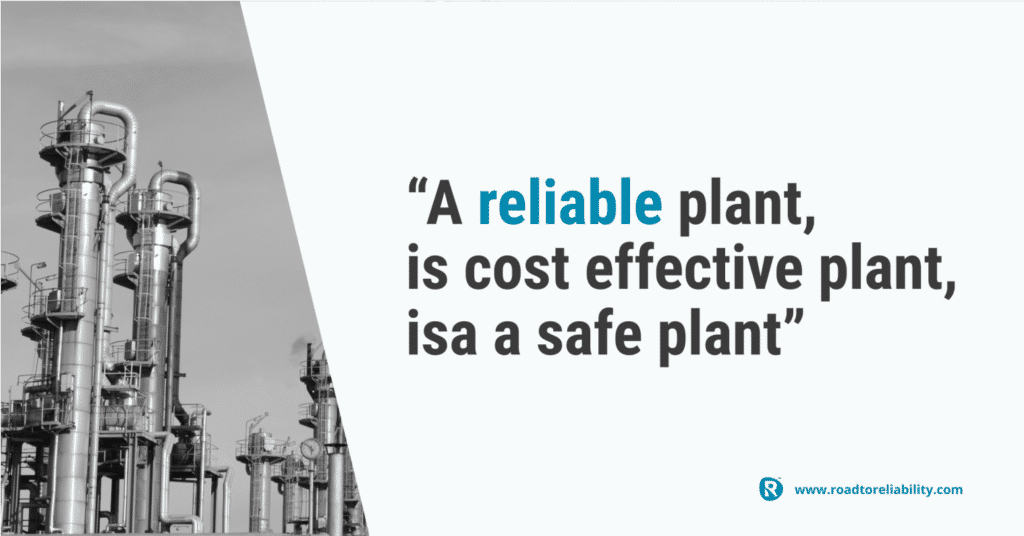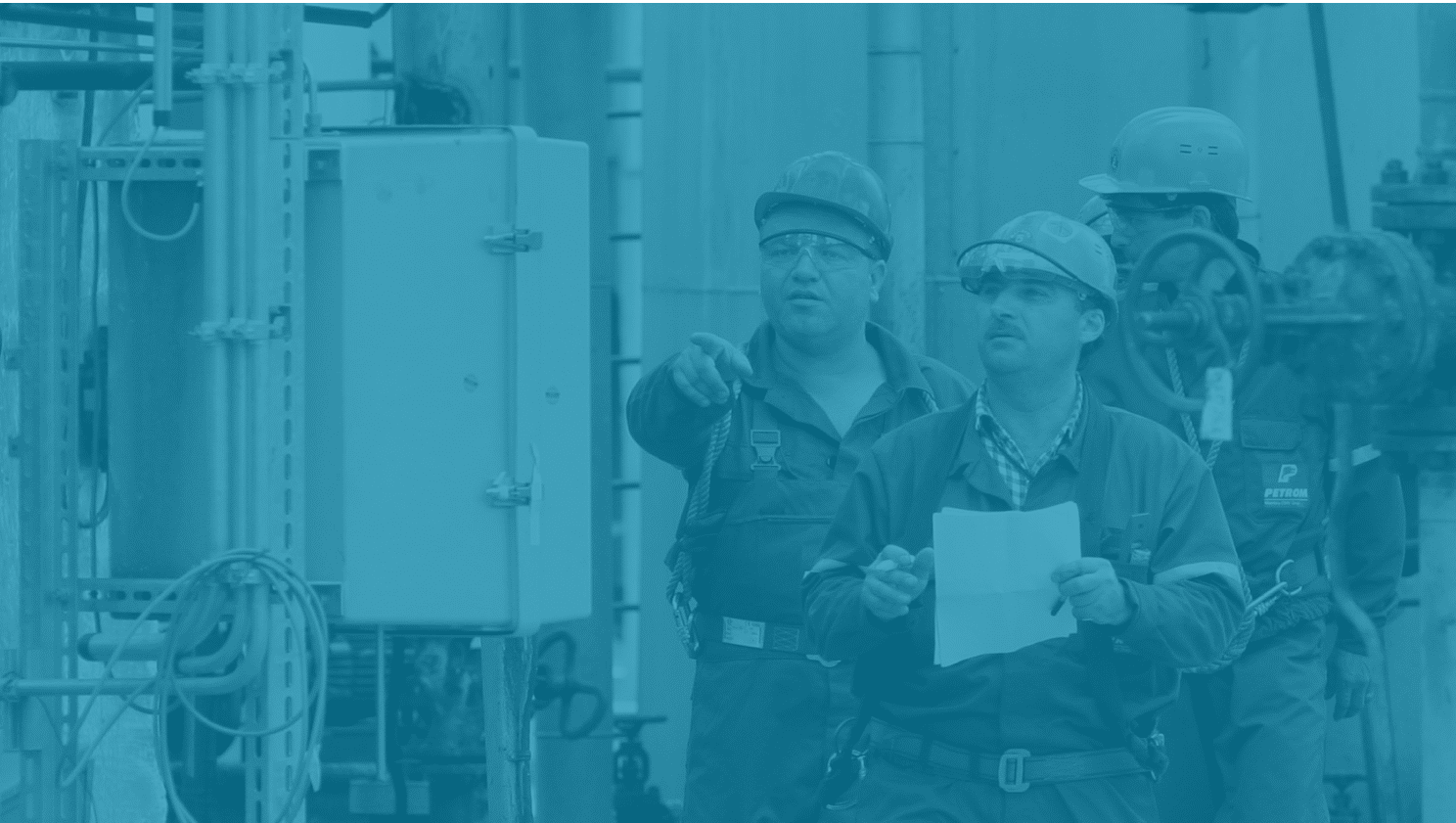No matter what industry or which country you look at, maintenance performance is pretty poor on average. That’s obviously not a good thing. But what makes it worse is that the principles of modern maintenance management have been well defined and documented for a good 30+ years. So why, after all this time, do so few organisations achieve excellent maintenance performance?
To be honest, it’s not all doom and gloom. There are certainly star performers out there. A handful of companies that deliver a world-class maintenance performance. What is it that they do that the rest of the industry can’t seem to pull off? Is maintenance management so hard that only few companies can master it?
We all know that plant maintenance is not rocket science. It really isn’t that complicated. It really isn’t that hard. So it’s not unrealistic to expect a lot more companies to do a lot better when it comes to their maintenance management.
I see several problems that together result in poor maintenance performance all round. The most important of these are:
#1: We Keep Making Something Simple So Complicated
#2: We Still Don’t Understand the Principles of Plant Maintenance
#3: Most Industries Don’t Design for Reliability
#4: We Keep Rewarding Poor Plant Maintenance
#5: We Keep Thinking of Maintenance as a Necessary Evil
#6: We Blame Others for Not Wanting to Change
#7: Maintenance Management Lacks Leadership
#8: There is Not Enough High Quality Maintenance Education
Let’s have a closer look at each of them.
Problem #1: We keep making something simple so complicated
First of all, we’ve made it all much more complicated than it needs to be. Ever looked at the maintenance excellence model provided by a typical consultancy? Models with 15 or 20+ elements are not uncommon.
And then I haven’t even touched on the use of so many acronyms:
Or opt for TPM?
Do you do CBM or PDM?
What about RBI?
When was the last time you did an FMECA or FMEA?
RCA or RCFA anybody?
So many of these acronyms overlap. So many are not clearly defined. Some are just plain confusing. And most are not well understood by many of the Maintenance & Reliability (M&R) professionals around the world.
The consequence of all this unnecessary complexity?
We do not focus enough on what really matters.
We do not focus enough on the basics of maintenance management.
Too often, we end up chasing fancy-sounding acronyms. One after the other we go for the latest trend in the industry. In the process, we ignore the simple basics. And that’s to our own detriment. Because it’s exactly those basics that enable maintenance excellence and high reliability.

This is not just my view. Research was done in the late 1990s by Winston Ledet and others showed that the best performers focus on the basics.1 And they do these basics exceptionally well.
That study showed that top-performing plants achieve 90% less downtime. And about 15% extra uptime. They achieved that by focusing on three things:
- planning & scheduling;
- preventive (and predictive) maintenance;
- and defect elimination.
This fits with what I’ve seen in my own experience. Whether that was in Europe, Asia, the Middle East or Australia. Every time it was the same. The best performing plants applied laser-like focus to the basics. And did these basics exceptionally well.
Adopt an overly complicated approach and you will lose sight of those basics.
I believe that as an industry we need to provide more simple solutions and frameworks to all those thousands of plants around the world that are struggling to achieve reliable operations.
Simplicity helps to create focus and a belief that you can do it.
That’s exactly why I created the Road to Reliability™ framework.
Problem #2: We still don’t understand the principles of plant maintenance – even after 40 years
Second problem? A large knowledge gap in the global maintenance and reliability community. There are many well-spoken, extensively published experts out there. No doubt about it, we have a very capable community with real centers of expertise. We have real thought leaders. And it’s an active community.
But we also have a wide disparity in capability.
There are thousands of maintenance and reliability practitioners around the world. And many have gaps in their knowledge and understanding of basic maintenance principles.
When talking to people across the globe I find that many maintenance and reliability practitioners still don’t really understand the concepts that Reliability Centered Maintenance (RCM) teaches us.
Knowlan and Heap completed their research that lead to the birth of RCM in the late 1970’s – so that’s some 40 years ago.
John Moubray’s published his RCM II book some 20 years ago, in 1997! 2
Despite all that time, all our industry standards, countless industry books, and free online resources, many organisations across the world still fail to apply these principles.
As an example, RCM teaches us that most failure modes are not the result of wear out or have age-related failure modes.
In fact, most failure modes show a random failure pattern. That means the likelihood of the failure occurring tomorrow is just as high as the likelihood of it failing next month. Or in 3 months’ time.
How many maintenance managers or plant engineers do you know that understand this?
And I don’t just mean theoretically. But in practical terms that translate to what PM tasks we do and why. Conducting a time-based replacement to deal with a random failure mode is a waste of time. Yet it remains a common practice in many organisations.
So how do we address this gap in knowledge and understanding?
The only way to resolve this gap is education. We need to educate more on the fundamentals that drive maintenance & reliability performance.
We need to improve what we teach but also how.
The effectiveness of conventional classroom training is too low.
Most of the knowledge presented in classroom training is not retained by the trainees. In fact, most of it’s lost within a few weeks of the training. And rarely does that training lead to people making real improvements once back in their organisations. And so the return-on-investment for this type of training is close to zero.
The other problem with the classic, classroom-based approach to training is that too may people are left behind. There are just too many maintenance and reliability practitioners around the world that don’t have access to high-quality training.
But it doesn’t have to be like this.
With the internet, we can now run online, on-demand training courses. Courses that:
- run at a self-directed pace, anywhere in the world;
- give the students tasks to complete in their own workplace;
- help students to make a lasting, positive change in their organisation.
That motivates, creates value, and adds to the bottom line. And it closes the knowledge gap.
Problem #3: Most companies don’t design for reliability
Most companies don’t pay enough attention to reliability during the design phase. Projects focus on minimizing capital expenditure. And usually do little more than paying lip service to Lifecycle Costing.
Even in projects that do use Lifecycle Costing the impacts of design and equipment choices are not properly converted into higher operating costs, or reduced equipment reliability and availability.
The result is projects start up with sub-par designs. Built out of sub-par equipment. Often built and commissioned in a hurry which introduces plenty of defects.
The result? Soon after start-up, the plant maintenance teams find themselves overwhelmed by equipment failures. And the typical reactive maintenance cycle starts.
This is the time when companies start to pay attention to reliability. Because now, the lack of reliability is hurting their bottom line. The problem is, by now it is exponentially harder – and exponentially more expensive! – to resolve those reliability issues.
You can only reach the inherent reliability of your equipment. That is, your plant can only be as reliable as it’s been designed to be. So if you struggle with poor design, poor equipment selection or poor installation you cannot maintain your way out of that. You will need to design those problems out of your plant.
You will need an effective defect elimination process.
Can we get companies in asset-intensive industries to take the same proactive approach to reliability as is common practice in the airline industry?
I’m sure we can, but it will take a lot of effort, time, and some serious leadership.
Problem #4: We keep rewarding poor plant maintenance performance
I can hear you argue: we don’t reward poor performance… Actually, most plants around the world do.
Not formally through the company key performance indicators. Instead, poor performance is rewarded through our culture and behaviours.
Our cultures reward a reactive maintenance strategy.
We don’t see many companies rewarding excellent preventive or predictive maintenance that prevented failures. A lack of failures usually does not hit the company ‘headlines’ so to speak. Nor does it translate into rewards.
Spectacular failures on the other hand do.
Those who respond heroically to high-profile failures often get a pat on the back for a job well done when everything is back online.
Some of my own best staff appraisals have been in years where I worked in a highly reactive maintenance environment. In a plant that was literally falling apart around us, my team and I got the best feedback in the situations when the whole plant was down and we busted our guts to get it back online before incurring million-dollar penalties. In one case we even chartered a private jet to fly some overseas specialists into the country. Praise all around for a world-class fire fighting performance.
But you know what?
The best thing we did was to slowly remove defects. To improve our PMs. And to implement a robust planning and scheduling process. We turned a reactive maintenance environment into one where we were on top of the work – not the other way round.
After 2 to 3 years the place was barely recognisable. Not just physically, but also in terms of productivity. We never received anywhere near as much praise for that as we did for our ‘heroics’ when the plant was down. Don’t get me wrong, I’m not complaining.
What I trying to show is that our cultures tend to reward the wrong things. We reward the so-called ‘overtime heroes’.
Instead, we should seek out those in our organisations that have prevented failures by the systematic application of good maintenance practices.
We should go out and find people who do good proactive maintenance work. Recognize their contribution and reward them. Look for things like a well-written new PM task. A CBM task that picked up an impending failure. Or someone who removed a defect. And recognise them.
Next time you have a major failure do not reward people for the fire-fighting or the overtime. Instead, be critical about why this was allowed to happen. Make sure your team does a Root Cause Analysis. And reward the completion of the RCA actions as a step to becoming less reactive.
Problem #5: We keep thinking of maintenance as a necessary evil
One of the most quoted problems, when you speak to Maintenance & Reliability Professionals, is “the culture” or the “lack of support” in their organisations.
I recognise these statements and these are definitely topics we need to address. But, we have to realize that culture and lack of support are often, in more ways than one, the consequence of another, underlying problem. And that is a lack of leadership.
When you point a finger remember that three fingers point back at yourself. As a maintenance & reliability community, we have to face the fact that when we find cultures that resist our desired change, or we do not get the support we need, we should look in the mirror and ask ourselves why we can’t get our message across.
Before we delve deeper into Leadership let’s explore the lack of support and culture issues a bit more in-depth.
The issue of lack of support comes down to how top management views planta maintenance. And typically, this is not too positive.
Maintenance is seen as a necessary evil.

In many plants, maintenance is only talked about, only gets attention, when things go wrong. When production stops, or worse, someone gets hurt.
This sets a negative culture. It doesn’t promote better performance or improvement. How many times have you as the maintenance manager felt marginalized? Felt that production is always the most important. That the maintenance department and its staff play second fiddle? Having to argue with Production to take equipment offline to conduct preventive maintenance?
Chances are this sounds familiar. Too many management teams forget that maintenance is key to higher reliability. That maintenance is a contributor to increased production and profitability. And that plant maintenance is an essential element to a safer working environment.
But it is. As Ron Moore once wrote: “A reliable plant is a safe plant is a cost-effective plant”.
So true.

Maintenance is often the largest controllable operating cost in asset-intensive industries. So of course, we must aim to reduce maintenance costs. But before we start cutting costs, we must remember that maintenance impacts:
- plant output;
- product quality;
- production costs;
- safety;
- and environmental performance.
If you simply cut maintenance costs you will shoot yourself in the foot. Things likely quality or production will suffer.
Usually, this doesn’t happen immediately. There is a time lag. That’s why many managers have gotten away with ruthlessly cutting maintenance. Increased their plant’s profitability in the short term and got their next promotion. We all know at least one or two managers who’ve done that. And gotten away with it.
But history is also full of examples of what happens next: poor reliability. Production and quality losses. And in some cases accidents with dire safety or environmental consequences. Lives lost.
Leaders of world-class plants treat maintenance different. They understand the relationship between maintenance, reliability, production, profitability, and safety.
They drive maintenance costs down by:
- eliminating defects;
- increasing productivity through effective work management;
- improving their preventive maintenance programs;
- and ultimately by real leadership
It’s exactly that approach, that level of understanding that we need to instill at all our plants.
How do we do this? Education is the only answer. As leaders, we need to educate our management proactively. We need to be able to sell the value maintenance and reliability bring to our organisations.
In short, as a leader, you need to be able to sell.
Problem #6: We blame others for not wanting to change …
A common complaint from those trying to improve maintenance one way or another is around the resistance in the organisation.
You’ve heard these complaints, if not have uttered them yourself:
“People don’t want to change”
“I can’t get XYZ to change the way they do things”
But is cultural resistance really the problem?
Any culture, no matter how good, or bad, is resistant to change.
Think of culture as a collective way of behaving, feeling, thinking, and believing. Once established those practices tend to protect themselves and resist change. So, instead of seeing resistance to change as a problem, accept it as a fact of life. A fact of life that we need to learn to deal with. Like we’ve learnt to deal with gravity or traffic jams.
You have to realize and accept that improving maintenance is more about people than engineering or technology.
As technical people, we like to deal with facts. With processes, systems, and technology. More so than engaging and motivating people. And that’s where it goes wrong.
If you want to improve your maintenance performance realize that those improvements will have to be delivered by people. Whether it’s your front line or engineering support, it always comes down to people. You will need to engage with them. You need to show them that there is a better way of doing things. You’ll need to motivate them to change. Explain what’s in it for them.
And before you get to that stage you need to convince your plant leadership to get on board. Fail to do that and you won’t get the resources you need.
So whilst culture is critical to our success it is not the resistance to change that is our problem. The real problem is that most maintenance managers don’t understand the value and importance of their organisation’s culture.
Too many maintenance managers fail to successfully engage and mobilize their organisation.
Often it is simply because they do not know how to. Or because they’re uncomfortable operating in that space. But they can’t be an effective leader like that.
What’s the solution? Well, you’ve guessed it, education. Practical, highly focused education that teaches and coaches maintenance and reliability managers:
- practical aspects of leadership;
- how to effective engage their organisation;
- the basics of initiating and managing change;
- and how to deliver improvement sustainably.
Generic, academic education won’t suffice. It needs to be practical and action-packed or it will fail to gain traction in our community.
Problem #7: Maintenance management lacks leadership
As we mentioned earlier, the most common problems raised by Maintenance & Reliability practitioners around the world is “the culture” and “the lack of support”.
I see these problems as symptoms of a deeper problem. A lack of real leadership focus on maintenance & reliability in most organisations around the world.
It’s not hard to understand why we would have a Maintenance Leadership problem. You see, most maintenance managers come up through the ranks. They develop strong technical skills, but are often not well versed in leadership or business skills.
Too many maintenance managers can’t sell the value of maintenance to their management. And so maintenance remains a necessary evil. Something that just costs money and not as a critical enabler to production and profit.
We also find that too maintenance managers don’t know what “good looks like”. What is a good maintenance performance? What makes it excellent or world-class?
If as a Maintenance Manager you do not know what good looks like then how do you know:
- How much your organisation could improve?
- What level of uptime you should be able to achieve?
- How much you can reduce your costs by?
- Or how much more product you can produce?
Without answers to those questions, you’ll never sell your improvements to senior management.
Unfortunately, the gap in leadership skills in our community is also evident from the poor track record of improvement projects.
So many improvement projects fail to deliver the promised results. That undermines credibility. And it often stops the drive for continuous improvement dead in its tracks. Organisations who fail to deliver on an improvement project often end up falling back into their old, reactive ways. Some do this consciously. In others, it happens by stealth. The results are dire in both cases.
So how do we address this leadership gap?
Again, education is the answer. We need education that teaches basic business and finance skills to our maintenance & reliability managers. Education that builds practical leadership skills that can be applied. Education that provides a solid understanding of what maintenance & reliability excellence looks like. And how to achieve it.
Now, the importance of plant leadership being involved in reliability has been long talked about, but Terrence O’Hanlon from www.reliabilityweb.com has really brought this to the forefront in recent years with his fantastic workaround Reliability Leadership® 1 and the Certified Reliability Leader (CRL) program. If you haven’t already had the chance to join the CRL program, you should certainly consider doing so.
Problem #8: There is not enough high-quality maintenance education
Equally important is the lack of high-quality maintenance & reliability management education. Only a small number of organisations deliver high-quality maintenance & reliability management training programs. Unfortunately, these programs are only available in a handful of locations. So of the thousands of maintenance managers working around the globe, only a few have access to this level of training.
So, how can we move our community forward if so many of them have no access to structured, high-quality training and coaching?
This is exactly why the Road to Reliability™ was founded. To provide world-class training to Maintenance & Reliability professionals around the world. Training based on a simple yet highly effective framework for reliability improvement. And in the coming months, we hope to launch the first course.
YOU ARE THE SOLUTION
In this article, I outlined why maintenance management around the world isn’t what it needs to be. And that’s an understatement. For each of the problems, I touched on potential solutions. Most of the solutions require the application of leadership, but there is one more common thread to all the solutions.
And that is YOU.
First of all, YOU must take action, educate yourself and educate others.
Secondly, YOU must determine what good looks like for your plant and prepare a vision to take your plant there.
Thirdly, YOU must enlighten your management so they value maintenance for the contribution it makes to the bottom line.
Lastly, YOU must act as a catalyst for this change.
This won’t be easy. In fact, it will be a struggle. Many plants don’t have terribly enlightened plant management. And change is never easy – even with full management support.
Which leaves you with a few choices:
- Continue to live the reactive life;
- Give up and vote with your feet and enjoy the reactive life in another plant;
- Or act as a Real Leader and chart a course on the Road to Reliability™
1. Reliability Leadership® is a registered trademark of NetexpressUSA Inc. DBA Reliabilityweb.com


